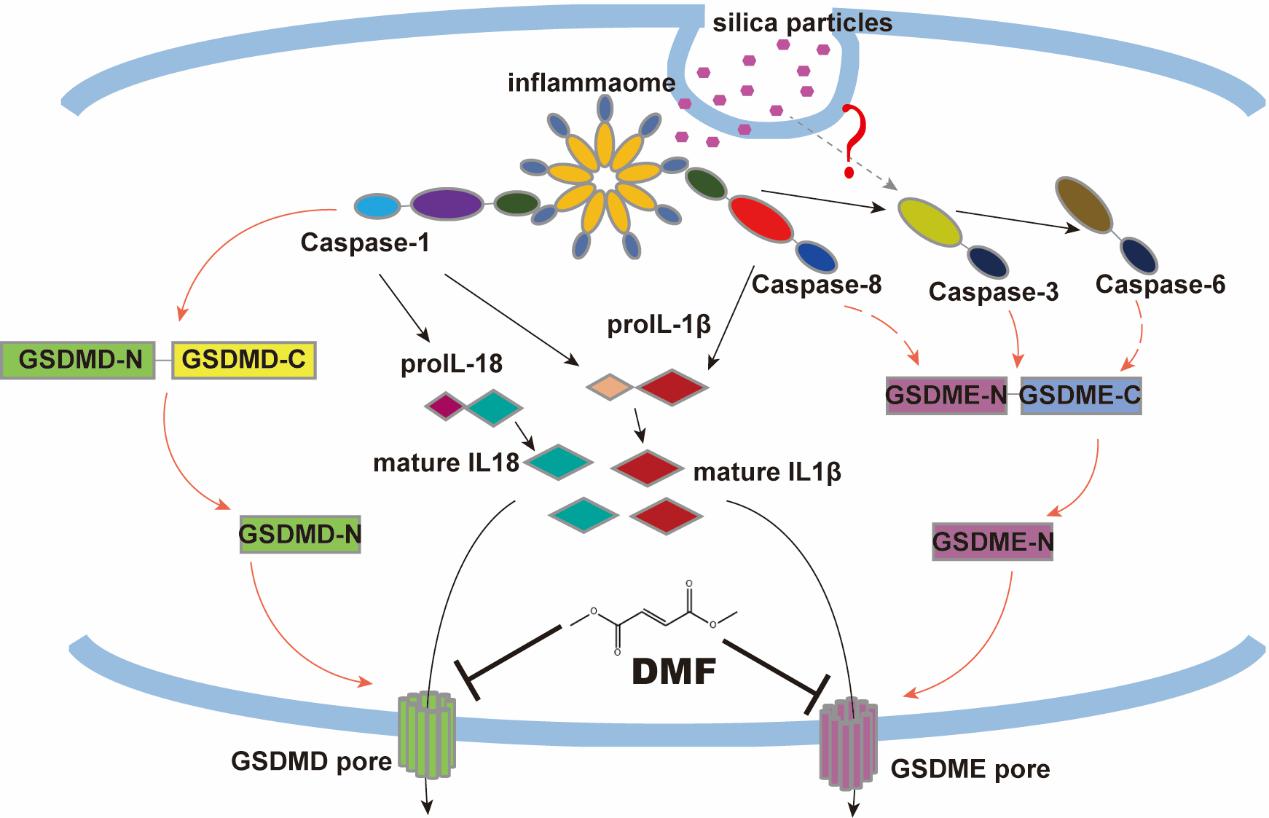inhalation of crystalline silica for prolonged periods leads to silicosis, which remains a prevalent occupational disease among mine workers. silicosis is featured by lung inflammation, pulmonary fibrosis, nodular lesions and eventual development of lung cancer. millions of patients suffer from silicosis, but it remains an uncurable disease due to its unclear pathogenic mechanisms.
on december 2, 2022, zhaoyu lin and xiang gao’s research group from model animal research center, nanjing university medical school, hourong cai’s research group from nanjing drum tower hospital, and jingyu chen’s research group from wuxi people’s hospital jointly published a research paper “blocking caspase-1/gsdmd and caspase-3/-8/gsdme pyroptotic pathways rescues silicosis in mice” in plos genetics (doi: 10.1371/journal.pgen.1010515). this work reveals that silica-induced cell lytic death and lung inflammation depend on two pyroptotic pathways, gsdmd and gsdme. in addition, the paper also analyzes the upstream caspases activation and downstream cytokine release in silica-induced pyroptosis, and finds a potential new treatment for silicosis.

phagocytosis of silica particles by macrophages leads to cell death and subsequent release into the extracellular microenvironment because they cannot be digested by macrophages. repeated cycles of particle uptake and release induce chronic inflammation and further pathological changes in tissues. this process is an important cause of lung inflammation and pulmonary fibrosis in silicosis. silica can activate nlrp3 inflammasome, and then initiate caspase-1/gsdmd-dependent pyroptosis and release of inflammatory cytokines. however, depletion of the nlrp3 inflammasome cannot block the silica-induced pyroptosis process. in addition, previous studies have also reported that caspase-1 knockout mice exhibit sterile inflammatory responses, suggesting that other signaling pathways regulate inflammatory cell death.
the researchers found the upregulation of gsdmd, gsdme, casp1, casp6, casp3, casp8, il1b and il18 proteins in alveolar lavage fluid from silicosis patient samples and silicosis mice. furthermore, in the silicosis mouse model, gsdmd and gsdme double-knockout mice showed a great relief of silica-induced lung inflammation and fibrosis, suggesting that in addition to the caspase-1/gsdmd pathway, gsdme is also critical for the silica-induced inflammation and lung fibrosis.
to identify possible caspases involved in silica-induced death of bone marrow-derived primary macrophages (bmdms), the researchers performed a screen using caspase inhibitors, including inhibitors from caspase-1 to caspase-12. caspase-3, caspase-6 or caspase-8 inhibitors increased the survival rate of bmdms treated with silica. this suggested that caspase-3, -6 and -8-associated pyroptosis is independent of nlrp3/caspase-1/gsdmd. it also demonstrated that caspase-3/-6/-8/gsdme-dependent pyroptosis is also the key to cell death.
since the related caspases not only mediate the cleavage of gsdmd and gsdme, but also mediate the maturation and release of cytokines. inhibiting these caspases may be one of the ways to treat silicosis. the researchers designed in vivo experiments to study the therapeutic effect of caspase inhibitors on silicosis. intraperitoneal injection of z-vad-fmk or caspase-1/-3/-8 inhibitors blocked the activation of pyroptotic markers and cytokines. dmf, an fda-approved drug, inhibits the cleavage of gsdmd and gsdme. finally, the researchers found that dmf also had a significant protective effect against silicosis in mice.
in summary, this study reveals that both the caspase-1/gsdmd and caspase-3/8/gsdme pathways are essential for the development of lung inflammation and fibrosis. inhibition of gsdme and gsdmd cleavage significantly blocks silica-induced pyroptosis and alleviates lung inflammation and fibrosis in mice (fig. 1). this study provides new potential targets and drugs for the treatment of silicosis.
associate professor zhaoyu lin and professor xiang gao, director hourong cai, and director jingyu chen are the co-corresponding authors of this research paper. lulu kang and yufang wang from model animal research center, nanjing university medical school, and jinghong dai from nanjing drum tower hospital are the co-first authors.
the research has been supported by the national natural science foundation of china, the ministry of science and technology of china, the ministry of education of china, the science and technology department of jiangsu province, and the fundamental research funds for central universities, as well as the assistance and support of the cooperative laboratories.

figure 1
schematic diagram of silica-induced pyroptosis and inflammatory pathways
(link to the paper: plos genet:)



